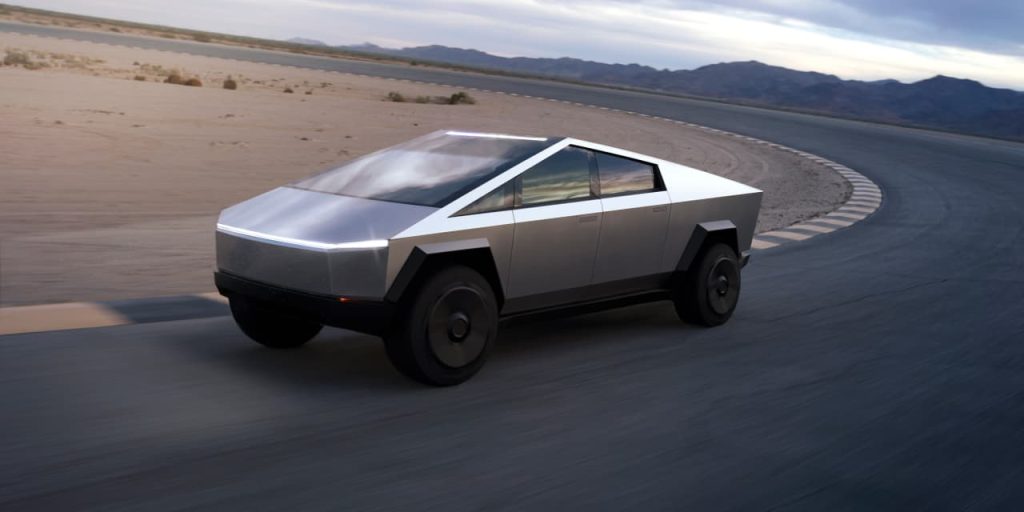This week, the myth finally becomes reality.
Tesla
(ticker: TSLA) hosts its Cybertruck delivery extravaganza on Nov. 30 in Austin, Texas. The event will be livestreamed on
Tesla
‘s website, and if history holds, on its YouTube channel.
The event signals initial deliveries going to initial buyers. It also means investors can start answering two key questions: Will the Cybertruck be a big seller and, just as important, will the avant-garde truck help boost sales of other Tesla models?
Answering the big seller question will take a while. Tesla CEO Elon Musk says the company won’t be making 250,000 Cybertrucks a year until at least 2025. The vehicle has proven difficult to manufacture.
The halo-effect question can be answered sooner. A new, cool model boosting sales of other, older models is that so-called brand halo effect. It isn’t a new idea in the car business. Cadillac, for instance, is launching the CELESTIQ EV, which starts at more than $300,000.
“There is a halo factor for that vehicle,” Tony Johnson, Cadillac marketing director, told Barron’s recently. It’s “important to the Calliac brand in terms of demonstrating the fact that we can design a world-class, ultra-luxury vehicle.”
Hopefully, CELESTIQ’s existence can boost sales of other Cadillac EVs, such as the LYRIQ, the coming EV version of the Escalade SUV, and the recently announced Cadillac OPTIQ.
It’s possible to argue Tesla has already experienced the halo-effect once. The Tesla Model Y may have boosted Tesla Model 3 sales.
The 3 was launched in 2017 and the Y was launched in 2020. Investors, at the time of the Y launch, feared the Model Y would cannibalize 3 sales. It didn’t turn out that way. Tesla sold more Model 3 vehicles in the U.S. in 2022 than it did in 2020 while also selling some 250,000 Y vehicles. Total U.S. sales for Tesla in 2022 were 150% higher than in 2020 and both the Y and 3 were hot sellers.
Investors don’t care about 2022 anymore. They care about 2023 and 2024. Globally, Wall Street expects Tesla to deliver about 476,000 units in the fourth quarter of 2023 and about 487,000 in the first quarter of 2024. With one quarter left in 2023, the Cybertruck halo might not impact late 2023 sales, but beating sales estimates in 2024 would help convince investors that Cybertruck was a good idea.
When Cybertruck was launched in 2019, the halo effect wasn’t first on investors’ minds. The truck was intended to unlock a lucrative market for Tesla.
Ford Motor
(F),
General Motors
(GM), Dodge, and
Toyota
have sold roughly 1.6 million full-size pickup trucks in the U.S. through the first three quarters of 2023. That is roughly 14% of all light vehicles sold.
With the Model 3, Y, and Cybertruck vehicle lineup, Tesla has more automotive market coverage but it still needs a smaller EV to compete with smaller, less-expensive Chinese EVs. What’s more, U.S. car buyers don’t have a lot of less expensive EV options.
The average nonluxury car in the U.S. costs about $44,000, according to Cox Automotive. The average battery electric vehicle costs about $52,000.
Despite higher pricing, the Model Y will likely end 2023 as the best-selling car on the planet. Not just the best-selling EV, the best-selling vehicle. It’s on pace to eclipse the
Toyota Motor
(TM) Corolla. One reason the Corolla sells so well is that it is a smaller, lower-priced vehicle.
A smaller Tesla is coming. Investors have taken to calling it the Model 2. The 2 might show up in 2024 or 2025. Tesla management has talked about it several times in recent months, but timing and design, as well as pricing, haven’t been pinned down.
Cybertruck pricing actually hasn’t been pinned down either.
Future Fund Active ETF
(FFND) co-founder and Tesla shareholder Gary Black believes the single-motor version will be priced at $49,990, the dual motor at $59,990, and the tri-motor version at $79,990.
All versions, at those prices, should qualify for the $7,500 Federal tax credit, which will be deducted from the dealer invoice price in 2024. The timing of the credit is a change from the Internal Revenue Service. EV buyers in 2023 have to claim the $7,500 tax credit on their 2023 tax returns.
Coming into the week, Tesla stock was up about 29% over the past 12 months while the
S&P 500
and
Nasdaq Composite
were up 15% and 29%, respectively.
When Cybertruck was launched in 2019, Tesla stock was at roughly $23 a share. It enters this week at more than $230 a share. When Tesla launched the Cybertruck back in November 2019, shares fell 6.1% as investors digested the design. It took about a week for shares to regain their pre-Cybertruck level. What will happen to Tesla stock this week is anyone’s guess.
Write to Al Root at [email protected]
Read the full article here















